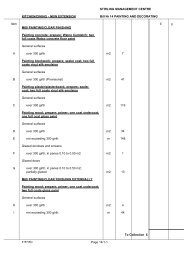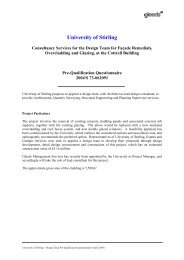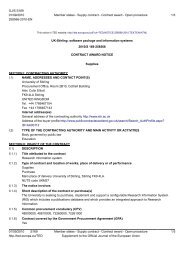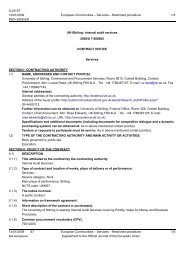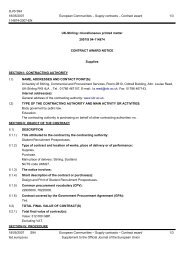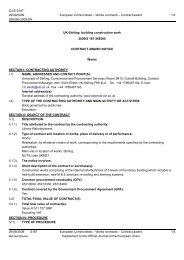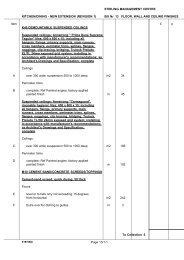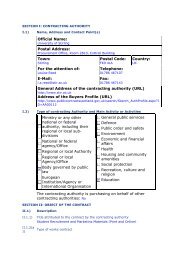estate strategy 2007-2017 - Publication Scheme - University of Stirling
estate strategy 2007-2017 - Publication Scheme - University of Stirling
estate strategy 2007-2017 - Publication Scheme - University of Stirling
- No tags were found...
Create successful ePaper yourself
Turn your PDF publications into a flip-book with our unique Google optimized e-Paper software.
the local/public policy contextacts to take place. The <strong>University</strong> has obligationswhich it is required to comply with both in its roleas a major landowner and as a potential developer.As the duties and obligations may change oncethe presence <strong>of</strong> a particular species is known ora particular habitat is formally designated theavailability <strong>of</strong> continuously updated informationis vital.As a starting point an Ecological Baseline Surveywas undertaken in <strong>2007</strong> (see Section 12) to identifyany important habitats and plant species, as wellas recording signs <strong>of</strong> fauna and areas <strong>of</strong> habitatthat may be suitable for protected species. Keyfindings were that the campus supports a variety<strong>of</strong> habitats, the most ecologically sensitive <strong>of</strong> whichare within the semi-natural and mature plantationwoodlands and water bodies, and that Pipestrellebats have historically roosted within the campusbut that no signs <strong>of</strong> other protected species wereidentified. However, this information will need tobe regularly reviewed.The current planning system is undergoingchange with a greater emphasis being placedupon biodiversity. <strong>Stirling</strong> Council, as the localplanning authority, provide within their Local PlanEnvironmental Keynote Policies. Any planningapplication submitted to the local planningauthority will be assessed against such policies.Statutory protection for flora and fauna falls intotwo categories with the highest level <strong>of</strong> protectionbeing given to what are termed ‘European Species’and a lesser but still high level <strong>of</strong> protection beinggiven to ‘nationally protected species’ as follows.There are a number <strong>of</strong> species that are given ahigh level <strong>of</strong> protection under European legislation.Protection extends to species <strong>of</strong> plant and birdlife. It is an <strong>of</strong>fence to deliberately or recklesslycapture, kill, injure, harass a European ProtectedSpecies (EPS) or deliberately or recklessly damageor destroy its breeding or resting place. In order toavoid criminal prosecution that would otherwisearise from these acts a licence must be obtainedfrom the Scottish Government. There is a rigorousscrutiny <strong>of</strong> all licence applications and there is astatutory test which is particularly difficult to meet.A number <strong>of</strong> species are given a degree <strong>of</strong>protection nationally. Badgers receive specialprotection under the Protection <strong>of</strong> Badgers Act1992 with it being possible to obtain a licencefrom Scottish Natural Heritage to avoid criminalprosecution. Again, certain species <strong>of</strong> plantand bird life are also listed. It is an <strong>of</strong>fence tointentionally or recklessly kill, injure or take anywild animal or intentionally or recklessly damage,destroy, or obstruct access to, a structure or placewhich a wild animal uses for shelter or protectionor disturb such an animal while occupying thatplace or structure. Development affecting thesespecies would not normally require a licencehowever a developer would need to meet thestatutory tests.The campus does not currently have any statutorilydesignated habitats for wildlife such as Natura2000 Sites (Special Areas <strong>of</strong> Conservation andSpecial Protection Areas) and Sites <strong>of</strong> SpecialScientific Interest (SSSI) both <strong>of</strong> which again havea high level <strong>of</strong> protection. There are, however,two non-statutory Local Wildlife Sites (LWS) <strong>of</strong>nature conservation interest which are protectedunder the planning system – Hermitage Woodand Airthrey Loch. Such designations and theneed to protect the sites concerned from adversedevelopment would be a material consideration inany proposed development. There are also areas<strong>of</strong> non-statutory designated woodland within thecampus including areas <strong>of</strong> Ancient Woodland andLong Established Woodland <strong>of</strong> Plantation Origin.The campus is also <strong>of</strong> geological interest becauseit contains raised beach sand deposits (goodexamples can be found close to the PathfootBuilding at grid reference NS803968) indicatinghigher sea levels in the Forth Valley in the past.The campus is an important teaching resource,particularly for the School <strong>of</strong> Biological andEnvironmental Sciences.19





